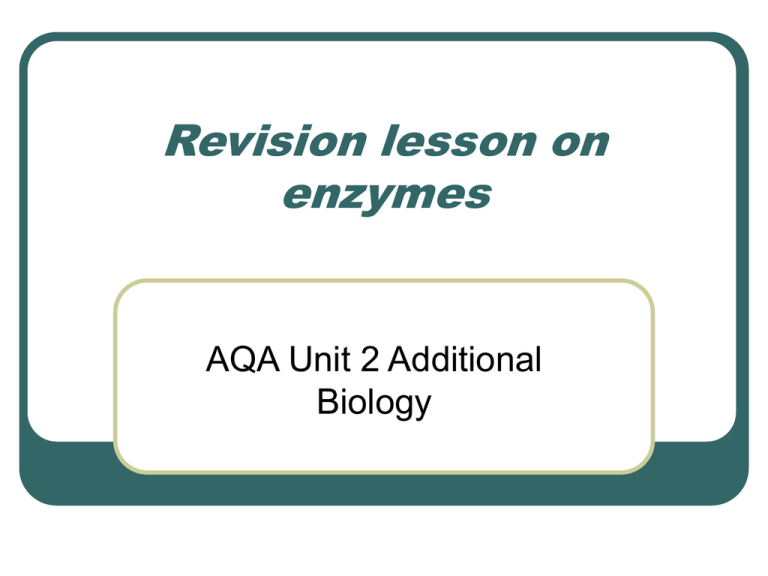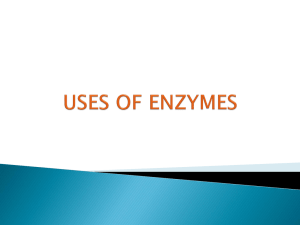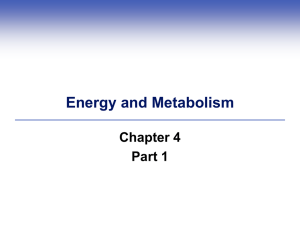Revision lesson on enzymes
advertisement

Revision lesson on enzymes AQA Unit 2 Additional Biology What are enzymes and what do they do? Enzymes are Protein molecules (made up of amino acids) Biological catalysts (Increase the speed of chemical reactions) Specific (Each one catalyses one particular reaction) Reusable (Can be used again and again) Affected by temperature and pH. Found in animals, plants and microorganisms. 2 main types of enzymes Catabolic enzymes which (break down) large molecules into smaller molecules e.g. digestion of starch by the enzyme amylase into glucose. Anabolic enzymes which (build up) small molecules to form larger molecules e.g. production of glucose during photosynthesis from carbon dioxide, water and light. Enzymes and activation energy Chemical reactions take place when particles collide with enough energy. The minimum amount of energy required is called the activation energy. Enzymes lower the amount of activation energy required, so the reaction can proceed at a greater rate. Structure of an enzyme molecule Enzymes are proteins made up on long chains of amino acids. These long chains fold to produce a special shape which is vital for the enzyme‘s function. Active Site How enzymes work Step-by-step Shape of the enzyme’s active site is complimentary to the shape of one particular substrate. The two bind together to form an enzymesubstrate complex. The reaction between them take place rapidly. The products are released from the enzyme’s active site. Complete Qu 1-8 on your worksheet. Factors affecting enzyme action - Temperature Enzymes work faster as the temperature increases up to 40oC, but are eventually denatured at about 60oC. This is because the shape of the active site is lost. Factors affecting enzyme action – pH Each enzyme works best at a particular pH. This is known as the optimum pH. Extremes of pH will cause the active site to denature. Answer Qu 8- 11 on your worksheet Enzymes in digestion Enzymes break down large insoluble food molecules into smaller, soluble ones which can be absorbed through the small intestine wall to enter the bloodstream. Different parts of the digestive tract have different pH conditions to enable different enzymes to work. The main groups of digestive enzymes Lipase enzymes digest fatty substrates. Protease enzymes digest protein substrates. Carbohydrase enzymes digest carbohydrate substrates. Substrate Enzyme Product Where Optimum enzyme pH produced Starch Glucose Salivary pH7 glands & pancreas Amino acids Stomach, pH3 pancreas, & small intestine Fatty acids & glycerol Pancreas pH8 Amylase (a carbohydrase) Protein Trypsin (a protease) Lipids Lipases (fats) The action of bile It’s produced by the liver and is stored in the gall bladder which, squirts it into the small intestine. It’s alkaline to neutralise acidic chyme coming from stomach. It emulsifies fats to break them into smaller droplets which increases the surface area for lipase enzymes to work. Commercial use of enzymes Product Enzymes Explanation Biological washing powder Lipases and proteases. Digest biological stains off clothes. Baby food Proteases Pre-digest protein to make digestion easier for babies. Slimming foods Isomerase (carbohydrase) Converts glucose into fructose (less of which is needed to sweeten food). Complete Qu 12- 17on worksheet.











